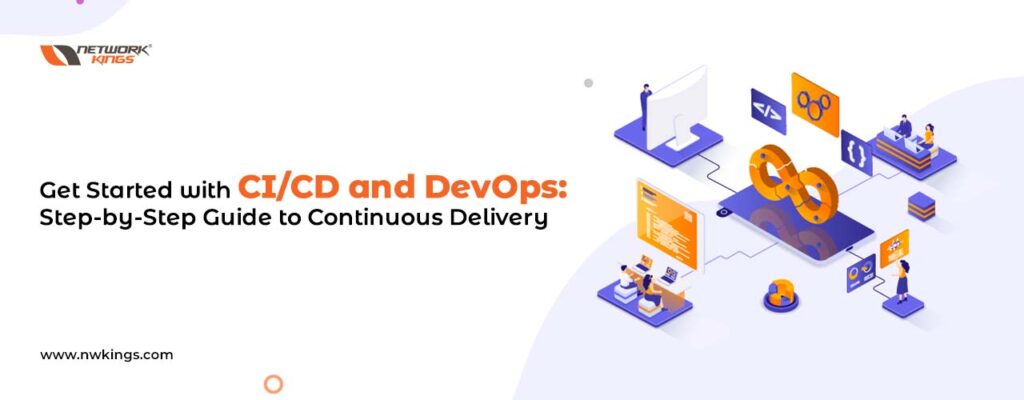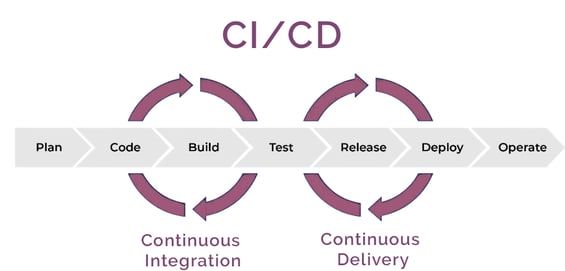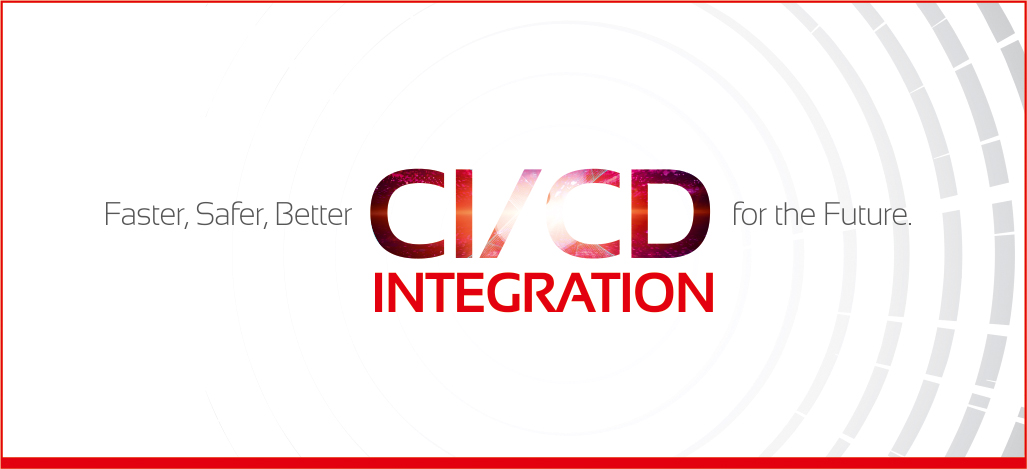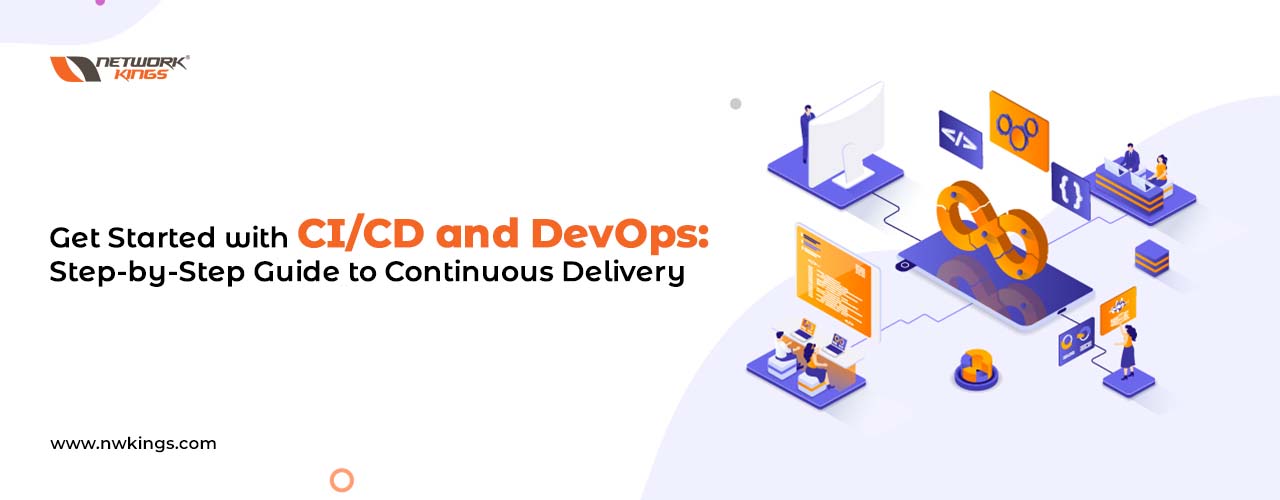
Are you ready to turbocharge your DevOps journey? Well, let us get acquainted with what is CI/CD in DevOps – a tremendous automation tool that can completely transform how you build and roll out your applications. With the help of CI/CD pipelines, continual delivery and deployment coordination, it is easy to handle complex development and production settings.
In this blog post, we will examine what exactly is CI/CD in DevOps terms as well as how it might help automate large parts of all those pesky dev tasks. Let us commence!
Understanding What is CI/CD in DevOps
DevOps and CI/CD fit together perfectly, enabling massive progressions in the development process. To put it simply, DevOps is all about joining forces between software dev teams and operations to get applications delivered more quickly. Contrarily, Continuous Integration (CI) and Continuous Delivery (CD) are both patterns for releasing software over quicker cycles which facilitate groups to rapidly deliver top-quality products.
The whole CI/CD structure can be divided into a few discrete steps with version control being the opening one – this allows coders to save several versions of their code.
This allows them to ‘roll back’ and revert to an earlier version of their code if something goes wrong, or for debugging purposes. When they have finished making the changes they want to make and check in the code, a build process kicks off that compiles it into an executable package. This package is then released into a staging environment where further tests can be conducted before finally being deployed on production systems. As part of this entire pipeline there are various stages where automated tests get run against each one; ensuring quality standards have been met whilst reducing any chances of bugs getting through onto live environments.
Eventually, once it passes through all the tests and stages in its release pipeline, it is ready to be deployed into production environments. Automation tools such as Ansible provide a way of guaranteeing consistent rollouts across different surroundings promptly and dependably – enabling teams to stay on top of deployment jobs even when there are numerous versions every day or week.
Understanding how DevOps and CI/CD integrate is essential these days; letting squads move expeditiously while still upholding superior quality levels throughout their development cycle. It also offers an efficient means of keeping track of alterations over time, knowing precisely what has gone out where and when – all vital aspects in creating successful applications that customers enjoy using!
Delving into CI/CD Explained in Layman's Terms

CI/CD is one of the key components of DevOps, but for newcomers, it can be tricky to get your head around. We are talking about Continuous Integration (CI) and Continuous Delivery or Deployment (CD); two practices that make use of automation technology to simplify software development processes. In simpler terms, CI/CD brings together frequently building code, testing code and deploying it quickly so users will benefit from new features as soon as possible.
At its simplest kind of understanding; CI involves running automated tests on newly added code to make sure that everything works correctly.
This process gives developers the ability to spot any potential issues early on in development when they are still relatively easy to rectify. By detecting mistakes before they end up reaching production systems, it becomes much easier for developers to avoid unnecessary and embarrassing errors later down the line.
The CD consists of sending or bringing code adjustments over into production environments once these changes have gone through tests and been given approval. This system is great at reducing deployment times from days or weeks right down to just a few minutes or hours without compromising reliability standards or quality levels either – amazing!
A positive aspect of CI/CD is that it doesn’t ask you to modify your coding approach – whatever programming language can be easily integrated into an automated process. Owing to modern cloud-based DevOps tools like Jenkins and GitHub Actions, a lot of contemporary organizations have already attained great results through their CI/CD pipelines.
For those who haven’t yet gotten themselves prepared for this level of automation, there are simpler alternatives such as manual builds and deployments which still provide some automation when compared with traditional methods. The solution you select largely depends on what’s needed by your organisation plus budget predicaments.
The Integral Role of CI/CD in DevOps Automation
CI/CD is a critical component of DevOps automation, which ensures organizations can reduce human error and make sure their software remains up-to-date on an ongoing basis. It combines the two concepts of Continuous Integration (CI) and Continuous Delivery (CD), forming one automated process that simplifies releasing software onto the market. Developers utilise CI/CD to construct, examine and launch applications swiftly yet efficiently.
The principal purpose behind establishing CI/CD is to reduce manual labour associated with rolling out apps while making certain each application released goes through no disruption or danger along its journey. With the use of CI/CD developers can point out faults promptly before they become pricey issues – How much time would have been lost if these errors weren’t picked up straight away? Taking this into account surely makes implementing such methodologies worthwhile as it acts like an insurance policy!
The great advantage of using CI/CD in DevOps automation is that it encourages a more nimble approach to developing products and services. Instead of waiting for tedious manual approval from different teams before changes can be implemented, developers now have the option to commit code into a repository and allow the CI/CD pipeline to do all the hard work afterwards. This significantly reduces the need for thorough QA cycles seeing as deployment processes are carried out automatically – making new features available quicker with fewer delays when releasing alterations to production environments. So how fast will you be able to release your next upgrade?
The huge benefit of using a CI/CD pipeline is that it reduces the amount of time needed to get new features released, without compromising either quality or stability. Plus, this kind of system encourages collaboration between developers and other stakeholders throughout product development: automation allows everyone on the team to see how their efforts contribute towards progress – from coding through deployment – which makes communication among teams much easier as everybody can stay up-to-date with what’s happening all the time.
Finally, setting up an efficient CI/CD strategy helps reduce any risks connected with launching software applications while speeding up release cycles so they’re speedy enough but still dependable for use in production settings and won’t fail due to misconfiguration or human errors. In today’s digital environment where businesses have to remain competitive by releasing products quickly (eg. e-commerce), having reliable tools like CI/CD might be essential if you want your business to survive!
An Overview of Continuous Integration in DevOps
Continuous Integration (CI) plays a big role in DevOps. It is the process of regularly merging code changes from different developers into a shared folder. Doing this helps you spot issues quickly, so they can be fixed before they become too tricky and expensive to put right. To make sure everything meets standard, automated testing and other quality control techniques are used as part of CI – if it passes all tests then it can be pushed out into production without any hitches or delays. Sounds ideal doesn’t it?
The reason for having Continuous Integration is to guarantee that new features are integrated faultlessly and the pre-existing ones aren’t messed up when the code goes live. Without CI, teams would have to wait until every change from all developers was complete before being able to verify whether it works or not; this would take significantly more time and money than employing CI does.
Bringing Continuous Integration into your DevOps practices considerably quickens release cycles while making sure the delivered code has quality. After each change is incorporated and examined via automated testing tools as well as manual verification processes if necessary, teams can get on with working on subsequent feature development. In addition, standardising dev environments makes certain there won’t be any sudden surprises due to unexpected discrepancies between developer PCs and production servers.
All in all, continuous integration within modern DevOps practices lets the team send out changes at a higher speed whilst maintaining an elevated level of assurance by keeping system stability intact and minimising downtime which may happen due to errors made during the coding delivery process.
Breaking Down the CI/CD Pipelines in DevOps

When it comes to DevOps, the CI/CD pipeline is top of mind. It plays a crucial role in any organisation’s development process, automating all steps between application code correction and deployment. So what are these pipelines about and how do they fit into this DevOps picture? Let us take a look at each component individually: continuous integration (CI) vs Continuous Delivery (CD).
The goal of both CI and CD is ultimately the same – they are designed to make development faster while enabling teams to issue more regular updates while maintaining a high-quality level for all aspects involved. In other words, alterations are done on different branches that then get linked up continuously; each part of the system needs testing for them to eventually reach their end target – production. That way we can better appreciate how CI/CD pipelines function as an integral element within DevOps.
In this development model (DevOps), developers have a working environment to call their own where they can concentrate on one particular task or feature without having any apprehensions about the other components or services being affected by their choices. Therefore, there is no reason for devs to be concerned with any dependencies or irregularities from different teams while dealing with what needs doing. However, that doesn’t signify that coders function in isolation – everyone must coordinate during startup so everybody entangled in the venture knows exactly what’s happening. Can you imagine how complicated projects would become if nobody talked?
Once developers have completed their coding of a feature, they can then commit those changes to a version control system. Popular examples include Git or Subversion[1], which allows them to share the code with others for review and provide feedback before these modifications get added to whatever ‘mainline’ branch is in use. How effectively do you think this process works? Does it take up too much time compared to other methods? Or does it help ensure that the project ends up as great as possible with minimal errors?
Once the changes have been reviewed and given the green light by other team members, they can proceed to what’s known as the continuous integration (CI) phase. At this stage, automated tests will be run on those changes to make sure there are no issues or bugs before deploying them into the production environment for end users’ access. This entire process needs approval at each step along the way – if anything fails during testing then developers would receive a notification so that they could identify and address any problem found easily enough.
Furthermore, automated deployment processes make sure the codebase is deployed into the production environment effectively and securely without any human assistance – once it has been checked that certain criteria are met such as passing automated tests then the application can be automatically released on a pre-planned schedule.
And last, we have continuous delivery (CD), which begins after the deployment phase – its main focus is gathering feedback from customers who use the deployed application, automating regular launches based upon customer feedback and usage data together with optimising existing app performance and scalability so businesses can better serve their clients while ensuring codebase stays clean and easy to look after continuously over time hence keeping future upkeep costs in check! Have you thought of what would happen if these maintenance tasks were not carried out regularly?
The Significance of Continuous Delivery in DevOps

The importance of Continuous Delivery to DevOps cannot be denied. It’s the ability to deploy any changes promptly and reliably – something which is essential when it comes to meeting development and deployment objectives. Of course, as we know, DevOps provides a collaborative platform for developers and operations teams through automation; with Continuous Delivery (CD) being an integral part of this process as it helps facilitate faster feedback loops, reducing cycle times while improving responsiveness towards customer requirements plus increasing system dependability alongside fast implementation of new features or fixes.
Continuous Delivery essentially means automating the release process so that any code modification can be pushed to production without needing software developers or IT administrators present. Doing this allows changes to reach customers quicker and also helps companies keep up with rapidly changing tech trends. The aim of Continuous Delivery is all about streamlining a rapid delivery cycle, which makes it easier for teams to detect issues earlier in development, reducing risk when introducing new features or updates while at the same time providing consistent quality assurance across releases. Eliminating manual intervention from key personnel during release processes, not only helps ensure changes reach customers more promptly but also has fewer chances for technical errors keeps released products safe too!
What’s more, Continuous Delivery can help bolster the communication between teams by giving everyone insight into what is being done at any one time. This assistance in reducing misapprehensions among different parts of an organisation during various phases of development; making sure that all data remains updated so that there won’t be anything halting to put out extra features or fixes. It helps keep everybody on the same page and avoids confusion which could lead to delays further down the line!
What’s great about Continuous Delivery is that it offers lots of benefits for DevOps teams. Teams get to work quicker on new features and bugs can be fixed quickly too; plus, any issues have a better chance of being spotted earlier due to the improved collaboration between departments. There is also much greater visibility into all development activities so it is easy to keep track of and monitor progress with minimum disruption.
Plus, stakeholders can access logs and stats regarding every aspect from feature requests right through to release cycles – giving them an overview they need to take action promptly if necessary! All this makes sure organizations stay one step ahead when it comes to advancements in technology while meeting customer expectations securely at the same time!
Deep Dive into Deployment Orchestration

When it comes to integrating and managing the various elements that are required for a software development project, deployment orchestration is what’s missing from DevOps teams. It can be thought of as the ‘glue’ which binds everything together and ensures all components work in tandem with each other. In this blog post, we are going to take an in-depth look at what deployment orchestration entails, and how it benefits your DevOps process significantly too.
DevOps often gets labelled as being a method of software development focused on collaboration between developers and operations personnel alike; something highly desirable within today’s digital landscape – but do you know just how much impact such working practices have?
To carry this out, developers use continuous integration (CI) and continuous delivery (CD) pipelines. CI/CD pipes give an automated road to join dev and ops teams by introducing computerization into the application build-deployment procedure. Deployment choreography is a method utilized related to CI/CD pipelines that encourages mechanisation of the whole arrangement of errands connected with constructing, trying, conveying, and pushing refreshes to applications running on numerous conditions (staging, testing production etc.)
How can organisations ensure their deployments are safe? Is it possible for them to do so even when they have complex setups across multiple environments?
By automating these tasks, developers can focus more on creating features rather than having to worry about manual deployments or configuration issues. Deployment orchestration is also great for multi-cloud environments where programs may need to run across different cloud providers such as AWS and GCP. Deployment orchestrators give a convenient way of monitoring progress in the deployment process – it is easy for technical leads or project managers responsible for deploying things to get up-to-date information on how their projects are faring at any given point in time.
In addition, they assist with rollbacks too – if something goes wrong during deployment, an array of activities that guarantee application integrity among various environments could be triggered by them so you don’t have mishaps down the line due to outmoded security policies or configurations drifting from what was set initially. Finally yet importantly
How CI/CD Facilitates Efficient Software Development?

When it comes to software development, the CI/CD (or Continuous Integration/Continuous Delivery) pipeline has become a real game-changer in the DevOps process. It helps teams create high-quality applications that reach their users quickly and reliably. The thing that makes CI/CD so effective is its capacity for automating major parts of the code delivery cycle – such as testing and deployment.
This leaves developers free to focus on more creative aspects of application creation instead of spending hours upon hours painstakingly coding manual processes. How can we make sure our apps roll out faster while still maintaining top-notch performance? That is where CI/CD shines!
Committing changes directly into version control systems like Git has made CI/CD possible, allowing developers to automate processes such as running tests on new or modified code, and building and deploying an application in production environments. Furthermore, automated verification steps can be included within these pipelines so that teams can make sure their newly added code meets quality standards before going live. But what exactly are the advantages of using a CI/CD pipeline?
Developers can free up more of their time to focus on what they excel in – writing clean, efficient code – instead of handling mundane tasks like compiling build scripts or supervising deployments. This makes them much more productive and encourages experimentation with the code without having to worry too much about breaking something else if standard procedures aren’t always followed each time changes are made.
On top of that, an automated system also cuts down errors caused due to human oversight during deployments or testing applications across different platforms. Automated tests ensure any bugs caught earlier get fixed before reaching production environments which saves a lot of hassle when it comes to labour-intensive manual testing processes as well as money usually spent on them both.
All things considered, implementing a CI/CD pipeline within a DevOps environment delivers great advantages from both productivity and QA point of view for software development projects so teams should look into how this could help speed up product improvements while keeping risk low at the same time!
Real-life examples of CI/CD in DevOps
Continuous Integration/Continuous Delivery (CI/CD) is a key element of DevOps and has become the accepted procedure for software development teams nowadays. It assists developers in making alterations to their code, swiftly building the software, examining modifications and then deploying it into production whenever they want.
By allowing DevOps teams to take on an accelerated approach when constructing as well as launching apps CI/CD helps ensure that quality applications are being delivered at a faster rate. But what does it mean practically? Let’s use a group working on one web application as an instance.
The team will employ version control systems, such as Git, to hold the codebase and trace different versions of the app. Whenever developers make transformations in the codebase, they can deposit these alterations into Git so that other members of the squad can spot them. This approach implies everyone is continuously informed about everybody else’s labour. Once a range of modifications has been committed to Git, it sets off a build process which compiles together all sections involved and operates automated tests against fresh functions or bug fixes – enabling quick assessment without waiting for manual checks from each member on board!
If all goes smoothly in this process, it implies that every new feature is tested correctly without any bugs or glitches being introduced. When these changes pass the tests they’re automatically deployed on production – meaning no delays when delivering fresh features or sorting out bug fixes for customers. For larger organisations who need extra highly developed tooling for their CI/CD pipelines, there are options like Jenkins and CircleCI which provide imposing automation characteristics as well as connections with cloud services such as Amazon Web Services (AWS) or Google Cloud Platform (GCP). Just imagine how much simpler life would be if your deployments were entirely automated!
These tools help further streamline processes by automating tasks such as running system health checks before pushing new code into production or executing automatic security scans within continuous integration pipelines. In doing this, development teams can concentrate more on the actual development and spend less time attending to administrative jobs associated with CI/CD procedures while remaining true to high system dependability levels.
CI/CD provides DevOps teams with an effective way of making sure that quality software is delivered frequently – all without the expenditure of valuable amounts of their time in manual testing activities which can then be used for trying out fresh ideas and techniques – something quite fundamental for today’s businesses!
Future Trends in CI/CD and DevOps Automation

CI/CD (or Continuous Integration, Continuous Delivery) and DevOps Automation are both highly sought-after topics in the software industry at present due to their potential to make development teams more efficient and reactive. So what exactly is CI/CD? Quite simply put, it is a process which allows developers to develop code quickly, test it automatically for accuracy then deploy it into production with minimal effort required.
As its name suggests, ‘continuous integration’ consists of regularly incorporating alterations from various development branches into one core branch – how do all these changes get welded together seamlessly without breaking existing features?
This allows developers to join forces on complex projects more quickly and make sure they are all working off the same version of code. The continuous delivery side then takes this integrated code and automatically sends it out into the production environment, making deliveries fast, consistent and dependable. To be able to achieve such a high level of effectiveness both CI/CD and DevOps Automation heavily count on automated tools like Jenkins for constructing pipelines as well as running tests – is that possible?
As AI-assisted automation is becoming more and more common in our industry, we should anticipate its further integration with DevOps processes. We could see advanced models providing alerts when something goes awry or offering assistance based on previous experiences. With the combination of existing DevOps toolsets along with these technologies, organisations will be able to lessen delays and bugs as well as enhance overall performance and quality significantly!
Containerisation technology such as Docker has revolutionised how applications are made and managed by enabling developers to package software safely within lightweight containers that can be deployed fast without any manual changes required for configuration. As this tech continues maturing – features like automated scaling and scheduling container instances across multiple data centres shall become much easier than ever before which would aid teams expeditiously dealing with sudden demand spikes or problems about live services or products!
Wrapping Up!
To sum it up, CI/CD is an essential part of DevOps which allows automation for rapid software development, deployment and delivery. By having a pipeline in place to automate the process you can ensure that builds are tested, and then deployed all as one orchestrated event – hence allowing Continuous Delivery; helping teams meet their release goals quickly and reliably. What’s more, this also helps make sure quality isn’t compromised along the way. It’s no wonder why CI/CD has become such an important factor when bringing new products or services to market!
Enrolling in our DevOps Masters Program could be one of the best steps forward for your career. We have put together comprehensive courses to give you an extensive knowledge base about DevOps principles, processes and tools so that you can shine in software delivery roles.
Our lessons are taught by experienced professionals who will make sure that they keep up with the latest technologies – giving you a firm footing on understanding current trends as well as how to identify and solve complex system configuration issues, automation challenges or performance-related problems. If learning advanced techniques of DevOps is what sparks your career ambition then this program might just be exactly what’s needed!
Don’t hang around; take advantage now and enrol on our Master Course straight away! It comes with complete flexibility meaning progress can happen at whatever pace works for each student while being coached along each step by highly qualified tutors whose experience speaks volumes when it comes to guiding others towards success. Make today count – sign up to get access to a valuable education which will send your prospects soaring!
Are you looking to propel your career and maximize your potential? Then it is time for you to join our DevOps Master Program! Our intense program will equip you with the training and tools necessary to work better, quicker, and more effectively. We will explain how cloud platforms, automation tools, configuration management solutions, and deployment strategies can be utilized. You will also learn about software engineering lifecycle best practices such as continual integration, continuous delivery service orchestration containerization monitoring etcetera.
Our DevOps Master Program provides a comprehensive understanding of DevOps principles and technologies while growing your professional network at the same time. With an emphasis on hands-on experience in a helpful atmosphere; we guarantee that this course will give you all the abilities required for success in today’s rapidly evolving technology sector – so why wait any longer? Make haste by joining us now and take the next step towards developing yourself professionally!
Happy Learning!


